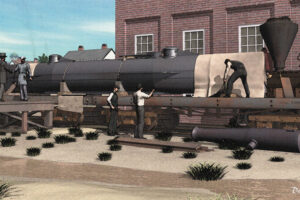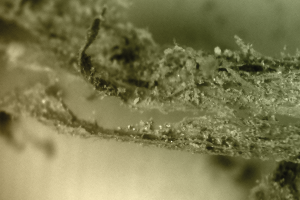This weekend the Civil War Sesquicentennial Celebration kicks off in Charleston. Though the 150th anniversary of the Hunley’s final voyage won’t happen until a few years from now, that doesn’t mean the modern day crew working to save the historic submarine are going to miss the opportunity participate.
Starting Saturday, April 9th, public tours of the Warren Lasch Conservation Center will have another major maritime artifact on display alongside the submarine. The Hunley team will unveil a new exhibit dedicated to the legendary raider CSS Alabama, with an original cannon recovered from her wreck site serving as the centerpiece. Lifting and moving the 5,000-pound cannon into the exhibit was no easy feat and was made possible by local supporters and companies, including Parker Rigging Company, Inc. and Deyten’s Shipyards of North Charleston, SC.
Two Alabama cannons were recovered from the wreck site in waters off the coast of France and conserved at the Hunley lab. The conservation process took several years and led to the discovery of human remains. Last year one of the cannons was shipped to the Museum of Mobile, where it is on display. Mobile is also the birthplace of the Hunley.
Senior Hunley Conservator Paul Mardikian has worked on Alabama artifacts on both American and French shores. Though the cannons were preserved using effective methods, Mardikian is quick to point out that the “subcritical” conservation technique currently being developed, researched and tested at the Warren Lasch Conservation Center could have saved a substantial amount of time and dollars. “Perhaps in the near future, the subcritical testing we have been doing on a small scale will provide us the opportunity to treat similar cannons in a fraction of the time required for these. Soon, what took us six years may take us six months,” Mardikian said.
ABOUT THE CSS ALABAMA
The Stuff of Legends
European waters may seem a strange place to find a confederate ship. A brief look at history, however, shows it not surprising.
The CSS Alabama patrolled waters around the globe but never once docked on the shores of its namesake state. The ship was built in secrecy in 1862 by British sympathizers to help with the Confederacy’s strategy to block Union supplies from abroad reaching American shores. It was an important aspect of the fledgling Confederate Navy’s attempt to combat the more established Union military. During the raider’s two years at sea, over 60 Union and merchant ships were intercepted by the Alabama and 600 million in prizes taken. Through all its adventure, not one of the Alabama’s crew– nor any of the ships it captured–were ever mortally wounded.
A Brave Ending
After a long, successful run, the Alabama had suffered substantial damage and wear and tear. In June 1864 the ship’s captain, Raphael Semmes, requested to port in Cherbourg, France to make desperately needed repairs. Once there, Semmes quickly learned he was cornered by USS Kearsarge, a Union sloop-of-war that had been in pursuit of the infamous raider. Though the odds were against the Alabama, Semmes refused to let his ship’s reputation be tarnished with surrender.
On June 19th, the battered Alabama gave the Kearsarge a gallant fight, but already at a disadvantage, the Confederate’s most successful raider ultimately lost and succumbed to French waters. The famous ship sank far away from its American home, a place where it never once anchored.
The courage of the against-all-odds battle earned Semmes and his ship an important place in Alabama history.
The wreck site would remain untouched for over 120 years, until exploratory and recovery efforts were conducted by a Franco- American expedition. The cannons were among many artifacts picked up from the site. Human remains were found fused to the cannon and were buried over a century later during a ceremony at Magnolia Cemetery in Alabama.
“This is a beautiful gun with an incredible history. We are lucky it survived,” Mardikian said.



